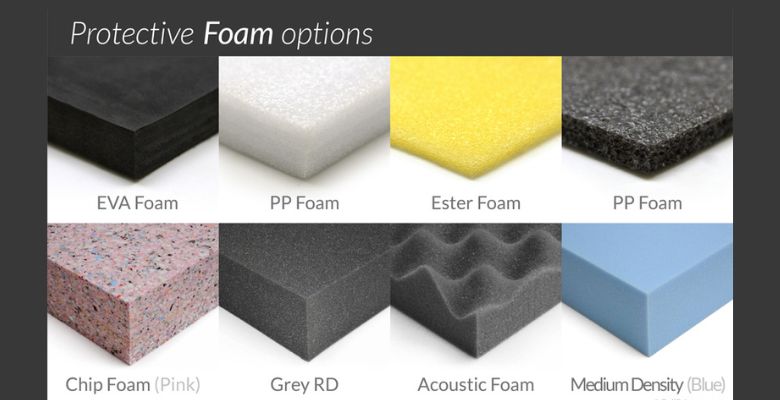Have you ever unboxed a long-awaited product only to find it damaged upon arrival? It’s a disappointment that no customer should experience. Foam packaging plays a pivotal role in preventing such letdowns. Providing a protective cushion during shipping and handling ensures that products reach customers in pristine condition, enhancing satisfaction and building brand trust.
But here’s the kicker: not all foam packaging is created equal. With various types tailored to different needs, selecting the right one can be a game-changer for your business. So, how do you make the right choice? Let’s dive deep into the world of foam packaging and uncover what you need to know!
Key Characteristics of Foam Materials
Density
Density is a fundamental characteristic that influences a foam material’s cushioning ability and protection level. The denser the foam, the better it can absorb shocks and impacts. This means that high-density foams offer superior protection for delicate items during transit, safeguarding them against inevitable bumps and drops during shipping. Choosing the right density is crucial to ensure that your products are well-protected without adding unnecessary weight or bulk.
Cell Structure
The cell structure of foam refers to the arrangement of its internal cells, which can be either open-cell or closed-cell. Open-cell foams are soft and flexible due to their interconnected pores, making them ideal for cushioning and sound absorption applications. They compress easily, providing a gentle cradle for fragile items.
On the other hand, closed-cell foams have sealed cells filled with gas, making them rigid and moisture-resistant. This structure provides excellent insulation and is suitable for heavy-duty protection and insulation purposes. Closed-cell foams are less compressible but offer greater durability and resistance to water and chemicals.
Compression Strength
Compression strength determines a foam’s resistance to weight and pressure. It’s a critical factor when products need to be stacked or stored for extended periods. A foam with high compression strength will maintain its shape and protective qualities under load, ensuring that the bottom items in a stack aren’t crushed or damaged. This characteristic is especially important in industries where products are heavy or where maximizing storage space is essential.
Read Also: Four Types Of Packaging That Prevent Tampering With Medicine
Types of Foam Packaging

1. Polyurethane Foam (PU Foam)
Polyurethane foam, commonly known as PU foam, is renowned for its softness, flexibility, and versatility. PU foam can be tailored to meet specific cushioning requirements and can be used in various densities and firmness levels. Its open-cell structure allows for excellent shock absorption, making it an ideal choice for protecting delicate items like glassware, ceramics, and electronics.
In practical applications, PU foam is often used to create custom foam inserts that snugly fit around a product, providing tailored protection. These inserts can be molded or cut into specific shapes, ensuring that every part of the product is shielded from impact. For example, a tech company once reduced product damage by 40% by implementing custom PU foam inserts for their electronics, highlighting the material’s effectiveness.
2. Polyethylene Foam (PE Foam)
Polyethylene foam, or PE foam, is known for its durability, lightweight nature, and resilience. Its closed-cell structure provides excellent water and chemical resistance, making it suitable for a variety of applications where exposure to moisture or harsh conditions is a concern.
PE foam is commonly used in packaging heavy machinery parts and automotive components due to its superior impact resistance and vibration dampening properties. It also offers edge protection for furniture and appliances, preventing dents and scratches during transit. Did you know that high-end kitchen appliance manufacturers often use PE foam to ensure their products arrive in perfect condition? Moreover, PE foam is reusable and recyclable, aligning with sustainable practices.
3. Expanded Polystyrene Foam (EPS Foam)
Expanded polystyrene foam, or EPS foam, is a rigid and lightweight material prized for its excellent thermal insulation. Its ability to maintain temperature control makes it ideal for packaging perishable goods and temperature-sensitive items like pharmaceuticals and certain food products.
EPS foam is also used for protective corners and blocks for large electronics, providing a cost-effective and easily moldable solution. Its high compressive strength allows for effective stacking without compromising product safety. Research has shown that EPS foam reduces thermal conductivity, effectively maintaining temperature control during transit and ensuring that products remain within safe temperature ranges.
4. Anti-Static Foam
Anti-static foam is specially designed to prevent electrostatic discharge (ESD), which can damage sensitive electronic components. Typically available in pink or black to indicate its anti-static properties, this foam dissipates static electricity, safeguarding items like microchips, circuit boards, and other delicate electronics.
In the electronics industry, anti-static foam is essential. It meets industry ESD standards, ensuring that products are protected from static-induced damage during manufacturing, handling, and shipping. Industry insights reveal that semiconductor manufacturers rely heavily on anti-static foam to prevent costly damages, highlighting its critical role in maintaining product integrity.
5. Convoluted Foam (Egg-Crate Foam)
Convoluted foam, often referred to as egg-crate foam due to its distinctive peaks and valleys, increases surface area and provides gentle cushioning. This design allows for even distribution of pressure and enhances air circulation around the product, which can be beneficial for items that are sensitive to pressure or require ventilation.
Commonly used in protecting delicate medical instruments and audio equipment, convoluted foam offers a balance of protection and lightweight convenience. Fun fact: musicians often use cases lined with convoluted foam to keep their instruments safe on the road, ensuring they arrive ready to perform.
6. Eco-Friendly Foam Options
With growing environmental concerns, eco-friendly foam options have become increasingly popular. Biodegradable foams, made from plant-based materials like cornstarch, decompose naturally without harming the environment. They offer similar protective qualities to traditional foams but with the added benefit of reducing environmental impact.
Recyclable foams can be reprocessed into new materials, supporting circular economy initiatives. These foams are especially appealing to eco-conscious brands looking to reduce their carbon footprint and meet consumer demand for sustainable packaging. Applications include packaging for organic products, natural cosmetics, and other goods where brand values align with environmental responsibility.
Environmental impact studies have shown that biodegradable foams can reduce landfill waste by 30% compared to traditional foams. This significant reduction underscores the importance of considering eco-friendly options in packaging strategies.
Customizing Foam Packaging

Custom Foam Inserts
Custom foam inserts offer numerous benefits that go beyond mere protection. By providing a tailored fit, they enhance product presentation and elevate the unboxing experience, which can leave a lasting impression on customers. This personalized touch reflects a brand’s attention to detail and commitment to quality.
Creating custom inserts involves techniques like die-cutting, which allows for precision cutting of specific shapes and sizes, and CNC machining, enabling complex designs with tight tolerances. These methods ensure that the foam insert perfectly matches the product’s dimensions and contours.
Luxury watch brands, for instance, use custom inserts to enhance the unboxing experience. The moment a customer opens the box and sees their watch nestled securely in a perfectly fitted insert can significantly enhance brand perception and customer satisfaction.
Foam Fabrication Techniques
Foam fabrication techniques expand the possibilities of foam packaging, allowing for innovative and practical solutions. Lamination involves combining different foam layers to add strength or combine properties of different materials. This technique can create a multi-functional foam that meets specific requirements.
Molding enables the creation of three-dimensional shapes for complex products, providing seamless protection without the need for assembly. Adhesive bonding assembles multiple foam pieces for intricate designs, offering flexibility in design and functionality.
In practice, industries like aerospace utilize molded foam for component packaging. By ensuring parts remain secure during long transits, they maintain the integrity of high-value components. These techniques demonstrate how foam packaging can be customized to meet the unique challenges of various industries.
Factors to Consider When Choosing Foam Packaging
Product Fragility
Understanding your product’s fragility is the first step in selecting the appropriate foam packaging. Assess how susceptible your product is to shock, vibration, and compression. Delicate items like glassware or sensitive electronics require foams with excellent shock absorption, such as PU foam. By matching the foam type to your product’s protection needs, you ensure that the packaging provides adequate defense against potential damage during transit.
Shipping Conditions
Consider the shipping conditions your product will encounter. The transportation method—be it air, sea, or ground—can affect exposure to elements like temperature fluctuations, humidity, and handling stress. Environmental factors such as extreme temperatures or high humidity levels can impact both the product and the packaging material. Selecting a foam that can withstand these conditions, like closed-cell PE foam for moisture resistance, ensures that your product arrives safely regardless of the shipping environment.
Budget Constraints
Balancing protection level with material costs is essential for maintaining profitability. Conduct a cost-benefit analysis to determine how much protection is necessary without overspending on packaging. Bulk purchasing of foam materials can lead to economies of scale, reducing the per-unit cost and making higher-quality foams more affordable. Remember, investing in better packaging can save costs in the long run by reducing product damages and returns.
Environmental Impact
Aligning your packaging choices with your company’s environmental policies can enhance your brand image and meet consumer expectations. With a growing preference for eco-friendly packaging solutions, considering sustainable foam options can set your business apart. Evaluate the environmental impact of different foam materials and choose ones that minimize waste and carbon footprint. This consideration not only benefits the planet but can also resonate with customers who value sustainability.
Industry Applications of Foam Packaging

Electronics Industry
The electronics industry faces the challenge of protecting sensitive components that require ESD protection. Anti-static and conductive foams are the solutions to prevent electrostatic discharge that can damage delicate electronics. According to industry studies, using anti-static foam can reduce component failure rates by 25%. This significant reduction highlights the importance of selecting the right foam packaging to maintain product quality and customer satisfaction.
Medical Equipment
In the medical field, sterility and protection from contamination are paramount. Closed-cell foams that are easy to clean and disinfect are ideal for packaging medical equipment. For example, custom PE foam inserts are used for surgical instrument kits to maintain sterility and organization. These foams provide a hygienic and secure way to transport delicate instruments, ensuring they remain uncontaminated and ready for use.
Read Also: Understanding Pharmaceutical Packaging: Primary, Secondary, and Tertiary Layers Explained
Automotive Parts
Automotive parts are often heavy and have irregular shapes, necessitating robust protection during transit. High-density PE foam offers the impact resistance needed to safeguard these components. Foam end caps and custom-shaped inserts protect engine parts and other vital components, ensuring they arrive without damage. This protection is crucial for maintaining the functionality and safety of automotive parts upon installation.
Aerospace and Defense
In the aerospace and defense industries, high-value items require maximum protection due to their critical nature and high replacement costs. Convoluted and laminated foams are used for precision equipment, providing tailored cushioning that absorbs vibrations and shocks. Research highlights that customized foam packaging reduces vibration damage in aerospace components, enhancing reliability and performance. This level of protection is essential for maintaining the integrity of components that operate under extreme conditions.
Environmental Considerations
Recycling and Disposal
Proper recycling and disposal of foam packaging are essential to minimize environmental impact. Check the availability of foam recycling facilities in your area to ensure that used packaging doesn’t end up in landfills unnecessarily. Following disposal guidelines helps reduce pollution and promotes responsible waste management practices. Encouraging customers to recycle foam packaging can also contribute to a positive environmental outcome.
Sustainable Alternatives
Innovations in foam packaging are leading to the development of materials made from renewable resources. These sustainable alternatives reduce dependence on petroleum-based products and decrease environmental footprint. Companies are increasingly adopting practices to reduce packaging waste, such as using recyclable or biodegradable foams. Corporate responsibility initiatives not only benefit the environment but also enhance brand reputation among consumers who value sustainability.
Read Also: Comprehensive Packaging Strategies for Small Businesses
Take Action: Considering eco-friendly foam options is a strategic move that aligns with global efforts to protect the environment. It not only benefits the planet but also resonates with eco-conscious consumers, potentially expanding your customer base.
Conclusion
Choosing the right type of foam packaging is more than just a protective measure—it’s a strategic decision that can enhance your brand image and boost customer satisfaction. By understanding the characteristics of different foam materials and considering factors like product fragility, shipping conditions, budget, and environmental impact, you can select the packaging solution that best fits your needs.
Ready to Elevate Your Packaging Game?
Don’t leave your product’s fate to chance. Consider all factors and make an informed decision. Partner with 99 designs packaging to find the optimal foam packaging solution for your business. The right choice can lead to fewer product damages, happier customers, and a stronger brand reputation.





